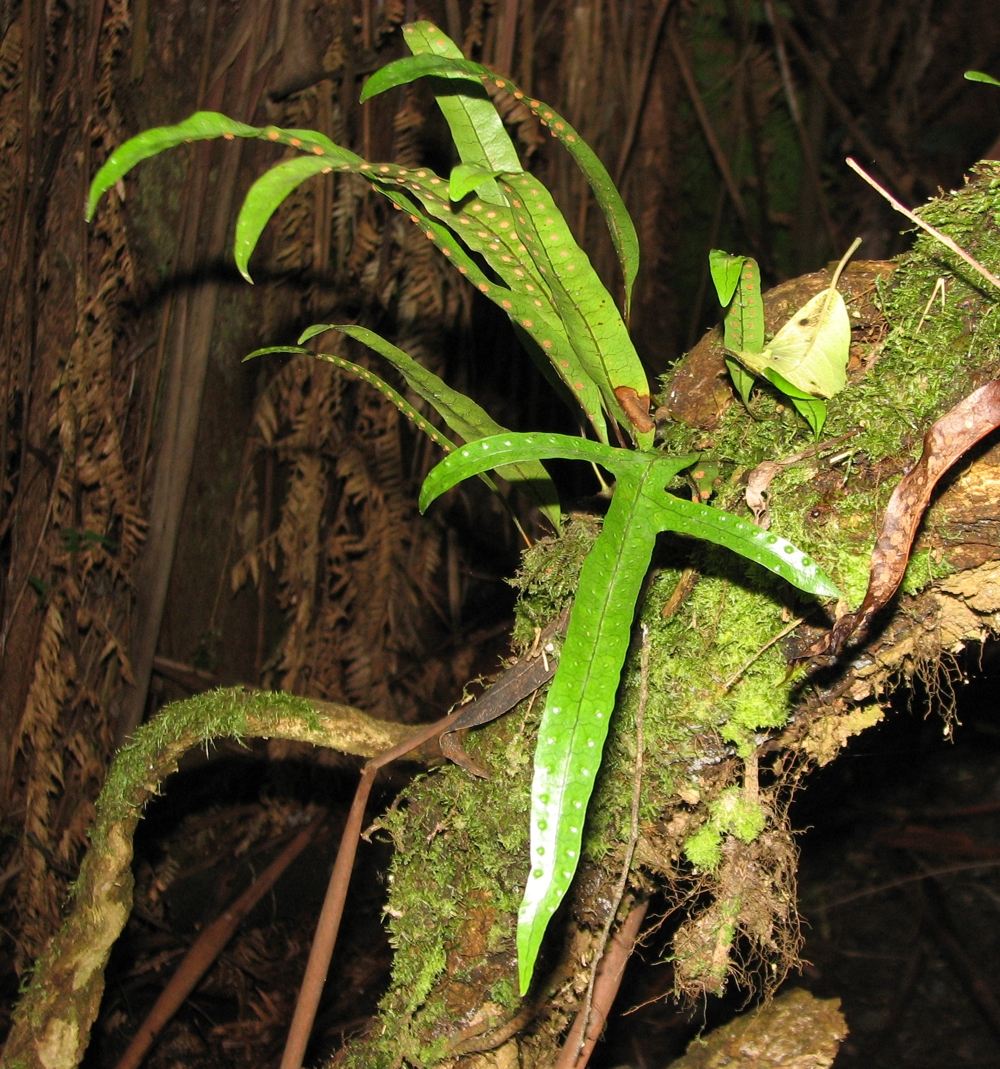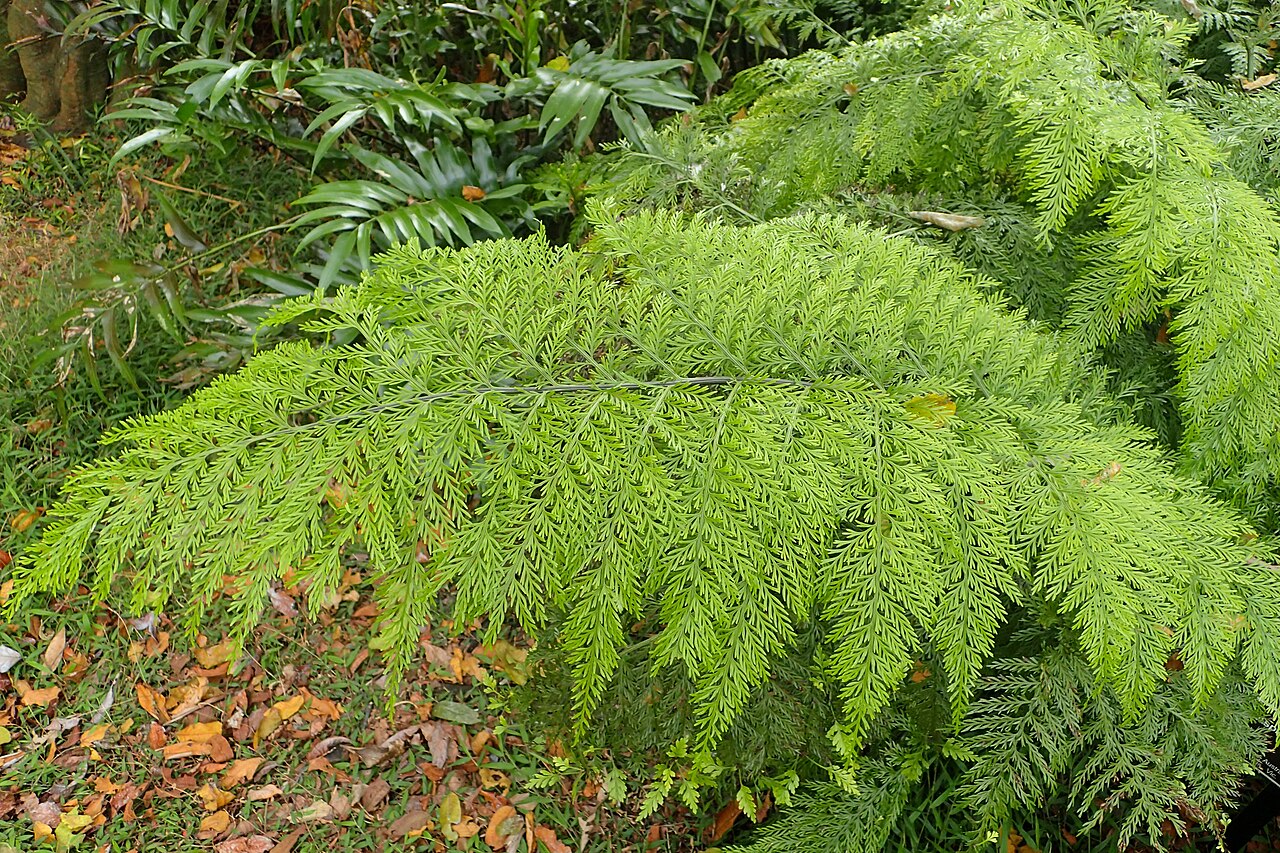Hound's Tongue Fern (Kōwaowao)
Microsorum pustulatum
Microsorum pustulatum, commonly known as Hound's Tongue Fern or Kōwaowao in te reo Māori, is a versatile and adaptable native fern of New Zealand. With its distinctive leathery fronds that resemble a dog's tongue, this epiphytic fern can be found growing on trees, rocks, and occasionally on the ground. Its ability to thrive in various conditions and its attractive, evergreen foliage make it both an important component of native ecosystems and a popular choice for gardens.

Image credit: Wikipedia
Quick Facts
| Height | 10-40 cm |
|---|---|
| Water Needs | Low to moderate |
| Light | Partial to full shade |
| Frost Tolerance | Moderate |
| Growth Rate | Slow to moderate |
| Lifespan | Long-lived perennial |
Climate Best Suited To
Hound's Tongue Fern is remarkably adaptable and can be found throughout New Zealand in suitable habitats. It thrives in humid, sheltered environments but can tolerate drier conditions once established. Its epiphytic nature allows it to grow in a variety of situations, from coastal forests to mountain slopes.
Regional Suitability
| City | Climate Suitability |
|---|---|
| Whangārei | Ideal |
| Auckland | Ideal |
| Hamilton | Ideal |
| Tauranga | Ideal |
| Rotorua | Ideal |
| Gisborne | Ideal |
| New Plymouth | Ideal |
| Napier | Moderate |
| Whanganui | Ideal |
| Palmerston North | Ideal |
| Wellington | Ideal |
| Nelson | Ideal |
| Christchurch | Moderate |
| Dunedin | Moderate |
| Invercargill | Moderate |
Growing Requirements
Substrate Requirements
As an epiphytic fern, Hound's Tongue Fern has unique growing requirements:
- Can grow on trees, rocks, logs, or in soil
- If planting in soil, use a well-draining, humus-rich mix
- For epiphytic growing, use sphagnum moss, orchid bark, or coconut fiber
- Prefers slightly acidic to neutral pH (5.5-7.0)
- Can be mounted on boards or grown in hanging baskets
- Tolerates poor substrates if moisture is adequate
Light Requirements
This fern prefers filtered light conditions:
- Dappled to deep shade
- Protection from direct sunlight, especially midday sun
- Morning sun tolerated in cooler regions
- Ideal under canopy of trees or on shaded rock faces
- Can tolerate brighter light if humidity is high
- Avoid hot, exposed sites
Water Requirements
Hound's Tongue Fern has moderate water needs:
- Regular watering when young or newly established
- Once established, can tolerate periods of dryness
- Allow substrate to dry slightly between waterings
- Benefits from misting in dry conditions
- Reduce watering in winter
- Ensure good drainage to prevent rot
Temperature Tolerance
Hound's Tongue Fern has the following temperature preferences:
- Prefers moderate temperatures
- Ideal growing range: 10-25°C (50-77°F)
- Can tolerate light frosts once established
- Protect from severe frost in colder regions
- Tolerates warmer temperatures if humidity is adequate
- Provide extra humidity during hot periods
Planting Guide
When to Plant
The best time to establish Hound's Tongue Fern is during the growing season when temperatures are mild:
- Spring to early summer is ideal for most regions
- Early autumn planting also works well in warmer areas
- Avoid planting during hot, dry summer periods
- Indoor planting can be done year-round
Where to Plant
Choose a location that mimics the fern's natural habitat:
- Shaded areas under trees or shrubs
- North or east-facing walls (in Southern Hemisphere)
- Rock gardens with adequate shade
- On tree trunks or stumps
- In hanging baskets or mounted on boards
- Sheltered from strong winds
How to Plant
Planting methods vary depending on whether you're growing epiphytically or in soil:
For Epiphytic Growing:
- Choose a suitable host (tree, log, or board)
- Secure the fern with fishing line, plant ties, or wire (which can be removed once established)
- Pack sphagnum moss around the roots
- Keep consistently moist until established
- Mist regularly to maintain humidity
For Soil Planting:
- Prepare a well-draining planting mix with organic matter
- Dig a hole twice the width of the root ball
- Plant at the same depth as it was growing previously
- Water thoroughly after planting
- Apply a layer of mulch to retain moisture
Spacing
When planting multiple specimens:
- Space plants 30-50 cm apart for ground planting
- Allow adequate space on trees or rocks for growth
- Consider the eventual spread when planning
Seasonal Care Calendar
Spring
- Increase watering as growth resumes
- Apply a diluted organic fertilizer if desired
- Ideal time for planting or transplanting
- Remove any damaged fronds
- Check for pests as they become active
- Divide plants if needed
Summer
- Monitor moisture levels, especially during dry periods
- Mist regularly to increase humidity
- Provide extra shade during hottest parts of the day
- Watch for pests and treat promptly if found
- Avoid fertilizing during very hot weather
- Collect spores for propagation if desired
Autumn
- Reduce watering as temperatures cool
- Good time for planting in warmer regions
- Clean up any fallen debris
- Check mountings or supports for epiphytic specimens
- Apply a light mulch for ground-planted specimens
- Last chance to divide before winter
Winter
- Reduce watering but don't allow to completely dry out
- Protect from severe frosts in colder regions
- Move container specimens to sheltered locations
- Avoid fertilizing during dormant period
- Plan for spring divisions or new plantings
- Enjoy the evergreen presence in the winter garden
Propagation Methods
Division
The most reliable method for home gardeners:
- Identify a mature plant with multiple growing points
- Carefully remove the plant from its substrate
- Gently separate the rhizomes, ensuring each section has fronds and roots
- Replant or mount divisions immediately
- Keep consistently moist until established
- Protect from direct sun and wind until new growth appears
Rhizome Cuttings
An effective method for increasing your collection:
- Select healthy rhizome sections with at least one growth point
- Cut rhizome into 5-10 cm lengths
- Allow cut ends to dry for a few hours
- Place on or slightly embedded in moist sphagnum moss
- Maintain high humidity until new growth appears
- Transplant once new fronds and roots have developed
Spores
For those wanting a challenge:
- Collect fertile fronds when spore cases (sori) turn brown
- Place fronds on clean paper in a warm, dry place for 1-2 days
- Collect the fine, dust-like spores that fall onto the paper
- Prepare a sterile growing medium of peat and perlite
- Sprinkle spores thinly over the surface
- Cover with glass or plastic to maintain humidity
- Keep at 18-21°C (65-70°F) in indirect light
- Mist with distilled water to maintain moisture
- Prothalli will form in 1-3 months
- Young ferns will develop in 6-12 months
- Transplant when several fronds have formed
Cultural History
Hound's Tongue Fern has a significant place in New Zealand's natural and cultural heritage:
Traditional Māori Uses
- Known as "kōwaowao" or "pāraharaha" in te reo Māori
- Used medicinally to treat skin conditions and wounds
- Fronds applied to burns and infections
- Used to wrap food for cooking in earth ovens (hāngī)
- Served as a calendar plant, with new growth indicating seasonal changes
Ecological Significance
- Important epiphyte in native forest ecosystems
- Provides habitat for small invertebrates
- Contributes to forest biodiversity
- Helps retain moisture in forest environments
- Indicator species for healthy forest ecosystems
European Settlement Impact
- Documented by early European botanists
- Habitat reduced through forest clearance
- Included in Victorian-era fern collections
- Specimens sent to European botanical gardens
Contemporary Significance
Today, Hound's Tongue Fern is valued both for its ecological role in native forests and as an ornamental plant in gardens. Its adaptability and distinctive appearance make it popular for both indoor and outdoor cultivation. Conservation efforts include preserving its natural habitat in protected forest areas and using it in restoration projects to rebuild native forest ecosystems.
Pests & Diseases
Common Pests
- Scale Insects: May appear on fronds as small bumps. Remove with cotton swab dipped in alcohol or use horticultural oil.
- Mealybugs: Sometimes infest the crown and base of fronds. Treat with insecticidal soap or neem oil.
- Slugs and Snails: Can damage fronds, especially new growth. Control with organic baits or barriers.
- Spider Mites: May occur in dry conditions. Increase humidity and treat with insecticidal soap if necessary.
Common Diseases
- Rhizome Rot: Caused by overwatering or poor drainage. Ensure well-draining substrate and avoid waterlogged conditions.
- Fungal Leaf Spots: Various fungi can cause spotting on fronds. Improve air circulation and avoid overhead watering.
- Powdery Mildew: May appear as white powder on fronds. Improve air circulation and treat with fungicide if severe.
Environmental Issues
- Desiccation: Low humidity causes frond edges to brown and curl. Increase humidity with misting or grouping plants.
- Sunburn: Direct sunlight causes yellowing and browning of fronds. Move to a more shaded location.
- Frost Damage: Severe frosts can damage fronds. Protect with frost cloth during cold snaps.
- Nutrient Deficiency: Yellowing fronds may indicate lack of nutrients. Apply a diluted organic fertilizer formulated for ferns.
Hound's Tongue Fern is generally resilient to pests and diseases when grown in appropriate conditions. Its leathery fronds are more resistant to damage than many other ferns. Good cultural practices including proper spacing, appropriate watering, and good air circulation will prevent most problems.
Bonus Tip
Create a stunning living wall display by mounting Hound's Tongue Fern on wooden boards or in vertical planting pockets. Its epiphytic nature makes it perfect for vertical gardening, and the leathery fronds add texture and interest to walls. Combine with other epiphytes like Pyrrosia eleagnifolia (Leather-leaf Fern) and Asplenium flaccidum (Hanging Spleenwort) for a diverse display that mimics natural forest growth patterns. Mist regularly to maintain humidity and ensure the mounting medium stays consistently moist until plants are established.


